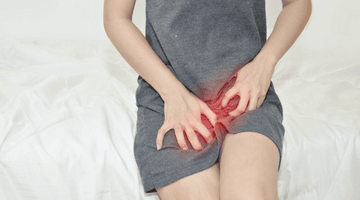Have you ever stopped to think about the environmental impact of your period? For most women, periods are a natural part of life, but the choices we make for menstrual care can have a lasting effect on the planet. From plastic-laden pads to disposable tampons, traditional menstrual products are contributing to global waste in ways we often overlook.
Did you know that a single pad can take over 500 years to decompose? Multiply that by the average number of menstrual products a woman uses in her lifetime, and the environmental footprint starts to look alarming.
But here’s the good news: making eco-friendly choices for your period doesn’t have to be difficult. From menstrual cups to reusable period underwear, sustainable options are more accessible than ever, offering benefits for both your health and the environment.
In this blog, we’ll explore the environmental impact of traditional products and guide you through eco-friendly alternatives that can reduce waste, save money, and help you manage your period more sustainably. Are you ready to make a positive impact on both your period care and the planet?
The Environmental Impact of Traditional Menstrual Products
Have you ever considered how many menstrual products you use in a year? The average woman uses about 11,000 pads or tampons in her lifetime. Now imagine how much waste that creates—especially when most of these products contain plastic.
Traditional pads are made up of about 90% plastic, which includes the absorbent core, packaging, and adhesives. Tampons may seem smaller, but they also contribute significantly to waste, particularly when plastic applicators are used. This plastic waste doesn't just disappear—it often ends up in landfills or oceans, where it can take centuries to break down.
But the environmental impact goes beyond just waste. The production of these single-use products involves energy-intensive processes and harmful chemicals, which contribute to pollution. Moreover, the disposal of menstrual products—whether flushed down toilets or thrown away—can cause environmental damage, clogging waterways and damaging marine life.
The good news is, there’s a growing movement towards sustainable menstrual products, which can drastically reduce your personal waste. Have you ever thought about switching to reusable options like period underwear or menstrual cups? These alternatives not only help the environment but can also offer you more comfort and control over your period care.
Eco-Friendly Menstrual Products: What Are Your Options?
Switching to eco-friendly menstrual products might feel overwhelming at first. But with so many sustainable choices available, you can find a product that fits both your lifestyle and the planet’s needs. Let's look at some of the greatest options:
-
Period Underwear
Have you ever considered using period underwear? These are reusable, absorbent undergarments designed to replace or supplement traditional menstrual products. Period underwear is made with special layers to absorb menstrual blood, and they come in various styles and absorbency levels. Whether you prefer a light or heavy flow, period underwear offers comfort, convenience, and zero waste.
The best part? They’re easy to use—just wear them like regular underwear, wash them after use, and they’re ready for the next time. Not only do they eliminate the need for single-use pads and tampons, but they’re also discreet and comfortable. Have you tried period underwear yet, or are you curious to give it a go? -
Menstrual Cups
Menstrual cups are a popular choice for those looking to reduce waste. Made from medical-grade silicone, menstrual cups are reusable, lasting for up to 10 years. They collect, rather than absorb, menstrual blood, and are inserted like a tampon. One of the major benefits of using a menstrual cup is that it can be worn for up to 12 hours, offering more convenience on busy days.
If you’re concerned about the learning curve of using a menstrual cup, don’t worry—there are plenty of online tutorials and resources to help you get started. Once you’re comfortable, you’ll likely find it to be one of the most cost-effective and eco-friendly options.

-
Reusable Cloth Pads
If you prefer the feel of a traditional pad, reusable cloth pads are a great alternative. They are made from absorbent fabric and can be washed and reused for years. These pads are available in various sizes and absorbencies, just like disposables, and they’re often made from organic materials that are gentler on the skin.
Reusable cloth pads eliminate the need for plastic liners and adhesives, making them a great choice for eco-conscious individuals. Plus, they come in fun patterns, which can make using them feel a bit more personal and enjoyable! -
Organic Tampons and Pads
If you’re not ready to make the switch to reusables just yet, choosing organic tampons and pads is a step in the right direction. These products are made from natural, biodegradable materials and are free from synthetic chemicals, plastics, and fragrances. While they’re still single-use, they break down more quickly than conventional options and have a smaller environmental footprint.
With so many eco-friendly products available, have you thought about which option suits your needs best? Whether it’s period underwear, a menstrual cup, or reusable pads, there’s something for everyone.
Benefits of Sustainable Menstrual Products
Why should you make the switch to eco-friendly menstrual products? Beyond the environmental benefits, there are a number of reasons why sustainable options might be the best choice for you.
-
Environmental Impact
By opting for reusable products like period underwear, menstrual cups, or cloth pads, you’re significantly reducing the amount of waste sent to landfills. Did you know that switching to sustainable options could prevent thousands of disposable products from being discarded during your lifetime? Brands like Padforher offer eco-friendly menstrual products that are designed to reduce waste and lower your carbon footprint. -
Cost Savings
At first look, reusable goods such as menstrual cups or period pants may appear more expensive than disposable options. However, think about how much you spend each month on pads or tampons. Over time, reusable products can save you money since they last for several years. For example, a menstrual cup can be used for up to 10 years, and period underwear can last a long time with proper care. -
Health Benefits
Many traditional menstrual products contain synthetic materials, fragrances, and even harmful chemicals. By switching to organic and reusable options, like those from Padforher, you’re choosing products that are free from harmful toxins. This reduces the risk of irritation, allergic reactions, or infections. -
Comfort and Convenience
Have you ever tried period underwear and noticed how much more comfortable they are compared to pads? With no shifting or bunching, period underwear feels like wearing regular underwear. Similarly, menstrual cups can hold more blood than tampons, meaning fewer changes throughout the day.
Making the change to sustainable products isn’t just good for the environment—it can improve your menstrual experience as well. What’s stopping you from making the switch?
How to Care for Reusable Products
Worried about how to care for your reusable menstrual products? It’s easier than you might think! With the right care, products like period underwear, menstrual cups, and reusable cloth pads can last for years, making them a truly sustainable choice.
Here are some tips to keep your eco-friendly products in top shape:
-
Washing Period Underwear
After use, rinse your period underwear in cold water to remove excess blood. Then, wash them either by hand or in the washing machine, following the care instructions on the label. Most period knickers, like those sold by Padforher, are built to last and may be machine washed on a mild cycle. Bleach and fabric softeners should be avoided since they can damage the absorbent layers. After washing, gently air dry them. -
Caring for Menstrual Cups
Menstrual cups need to be cleaned both during and after your period. During your cycle, it’s enough to rinse your cup with water when emptying it. After your period, it’s a good idea to sterilize the cup by boiling it in water for a few minutes. This ensures it’s hygienic and ready for next month’s use. With proper maintenance, menstruation cups can last up to ten years! -
Cleaning Reusable Cloth Pads
Like period underwear, reusable cloth pads should be rinsed in cold water after use to prevent stains. You can then hand wash them or toss them into the washing machine with your regular laundry. Be sure to air dry them to prolong their lifespan. Some cloth pads, like those offered by Padforher, are made from organic cotton and other natural fibres, ensuring they’re gentle on the skin.
Maintaining these products is simple and can easily fit into your normal routine. And remember, proper care not only keeps your products clean but ensures they last for years, reducing waste and saving you money. Have you started using any reusable products yet, or are you ready to make the switch?

Reducing Plastic Waste in Your Menstrual Routine
Even small changes to your menstrual routine can have a big impact on reducing plastic waste. Have you thought about how much plastic is involved in your current routine? From the wrappers and applicators to the products themselves, traditional period care contributes significantly to the global plastic problem.
Here are some simple steps you can take to make your period more eco-friendly:
-
Switch to Plastic-Free Products
One of the easiest ways to reduce plastic waste is by choosing products that don’t contain plastic. Padforher offers a range of plastic-free menstrual products, including organic pads and tampons, which are not only better for the environment but also free from chemicals and synthetic materials. -
Biodegradable Disposal Bags
If you’re still using disposable products, consider using biodegradable sanitary disposal bags. These are made from eco-friendly materials and break down much faster than traditional plastic bags, reducing the amount of waste that ends up in landfills. -
Choose Reusables
The ultimate way to cut down on plastic waste is by choosing reusable products like period underwear, menstrual cups, or cloth pads. Not only do these products eliminate single-use plastics, but they also reduce the overall waste generated by your period. Have you thought about trying period underwear or reusable cloth pads yet?
By making even small changes, you can significantly reduce your environmental footprint. Plus, encouraging others to make eco-friendly choices can amplify the positive impact we have on our planet.
Addressing Myths About Sustainable Menstrual Products
Are you hesitant to switch to sustainable menstrual products because of things you’ve heard? Let’s address some common myths and misconceptions about eco-friendly period care. You might be surprised by how easy and convenient these alternatives can be!
-
Myth: Reusable products are unhygienic
Some people worry that using products like period underwear, menstrual cups, or reusable pads might be less hygienic. In reality, when cared for properly, these products are just as sanitary—if not more so—than disposables. Washing period underwear and reusable pads after each use, and sterilizing menstrual cups between cycles, ensures they are perfectly safe and hygienic. -
Myth: They’re inconvenient and hard to use
Have you ever thought about switching to a menstrual cup but felt intimidated? Many people believe reusable products are complicated, but most users find that after a short adjustment period, products like menstrual cups and period underwear are extremely easy to use. Period underwear, for example, is as simple as wearing regular underwear—just wash and reuse! -
Myth: They’re uncomfortable
You might assume that reusable products like period underwear or cloth pads aren’t as comfortable as disposable pads. However, brands like Padforher have designed products with comfort in mind. Period underwear is made from soft, breathable materials, while cloth pads are gentle on the skin and free from the synthetic chemicals that can cause irritation. -
Myth: Eco-friendly products are expensive
While reusable products might have a higher upfront cost, they save money in the long run. Think about it—how much do you spend on disposable pads or tampons every month? Products like menstrual cups or period underwear can last for years, making them a cost-effective solution over time.
By addressing these misconceptions, we hope to show that switching to sustainable menstrual products is not only good for the environment but also practical, safe, and comfortable. What's stopping you from making the switch?

Conclusion
Incorporating eco-friendly choices into your period routine doesn’t just benefit the planet—it also offers health, comfort, and financial advantages. By switching to sustainable products like period underwear, menstrual cups, or reusable cloth pads, you’re taking a step towards reducing your environmental footprint while enhancing your personal period care experience.
Let’s recap some of the key points:
- Sustainable options, like those offered by Padforher, help reduce plastic waste and prevent harmful chemicals from entering your body.
- Reusable products can save you money in the long term and are designed to be comfortable and convenient.
- Myths and misconceptions about sustainable period care can be easily debunked once you learn about the real benefits.
It’s time to make eco-friendly choices that are better for both your body and the planet. Ready to give it a try? Start by exploring which sustainable products fit your lifestyle and remember—even small changes can make a big difference in the long run.
Together, we can care for both our periods and our planet.



